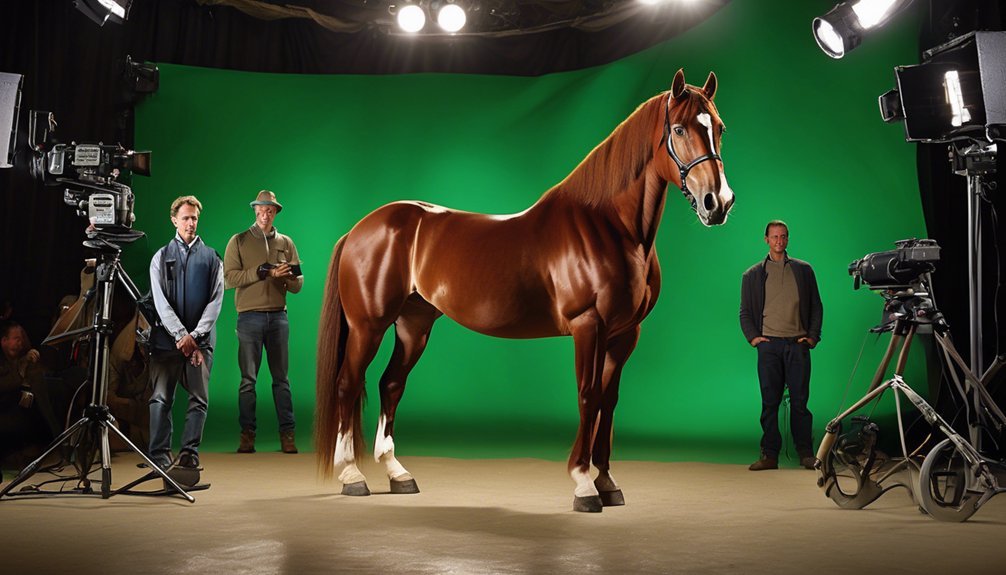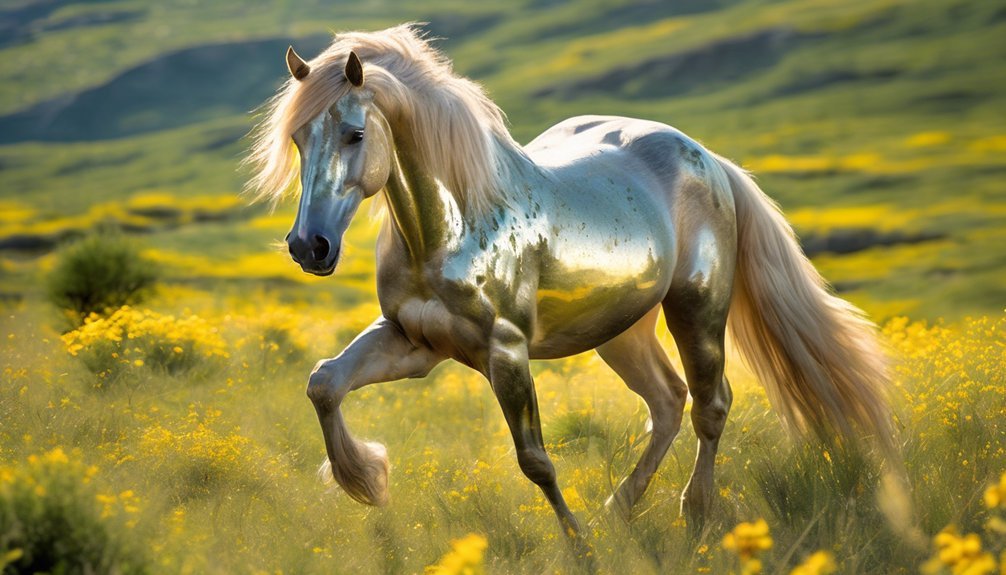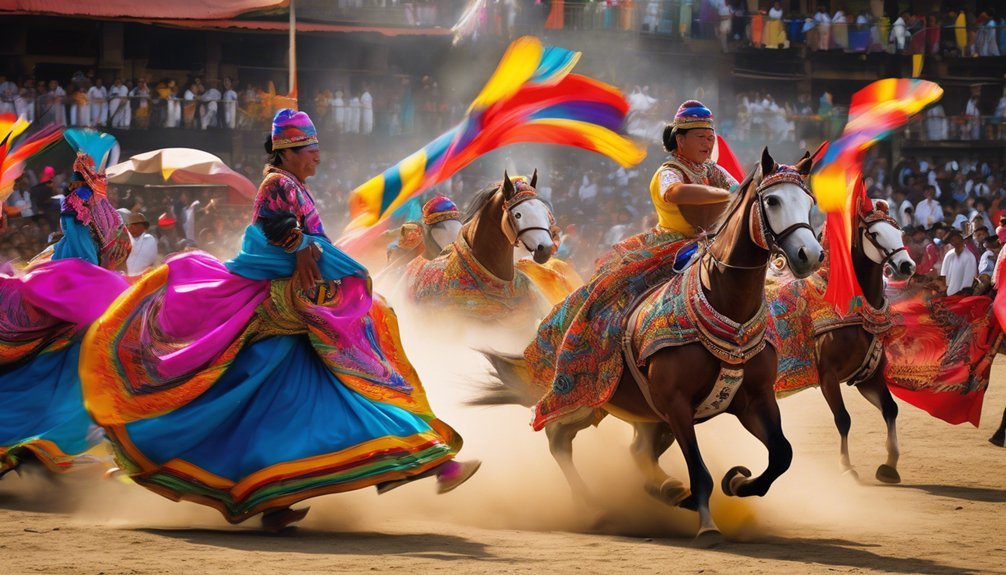
Training horses for film and television might seem as simple as teaching them to trot in front of a camera, but it's a complex art that requires patience and skill. You'll quickly discover that understanding equine behavior is just the beginning. Each horse has its own temperament, and the key lies in building a deep trust with the trainer. Curious about how this bond shapes the performance on set? Let's explore the fascinating techniques behind it.
Key Takeaways
- Horses are selected based on temperament, ensuring a suitable match for film roles and character requirements.
- Training focuses on establishing trust through gentle cues and consistent communication, enhancing the horse's comfort and responsiveness.
- Gradual exposure to film-specific tasks and environments helps horses adapt, building their confidence and ability to perform under pressure.
- Positive reinforcement, including clicker training and rewards, encourages desired behaviors and strengthens the bond between horse and trainer.
- Regular veterinary check-ins and safety protocols are essential to ensure the well-being of the horse during training and filming.
The Basics of Equine Training for the Screen

When it comes to training horses for film and television, understanding the basics is crucial.
You'll want to start with careful film horse selection, ensuring the horse's temperament aligns with the demands of on-set communication. A calm, responsive horse can adapt better to the hustle and bustle of filming.
Building a trusting relationship is essential; spend time getting to know your horse, using gentle cues to establish trust.
Consistency in training is key—focus on basic commands and gradually introduce film-specific tasks. You'll find that clear, patient communication with your horse fosters a positive learning environment.
Understanding Equine Behavior and Psychology
Understanding equine behavior and psychology is essential for successful training, as it allows you to communicate effectively with your horse. By observing their equine instincts, you can gain insight into their thoughts and feelings.
Pay attention to behavioral cues, like ear position or tail movement; these signals reveal your horse's mood and level of comfort. Building a bond takes time, so be patient and gentle, allowing your horse to acclimate to your presence.
Remember, each horse is unique, and understanding their individual quirks enhances your training experience. When you foster trust and respect, you create a powerful connection that makes training enjoyable for both of you.
Embrace this journey, and watch your horse flourish on screen.
Common Training Techniques Used in Film and Television
When training horses for film and television, positive reinforcement methods play a crucial role in building trust and encouraging desired behaviors.
You'll notice trainers often use treats or praise to reward the horse, making the learning process enjoyable for both parties.
Additionally, desensitization techniques help horses become comfortable with various stimuli, ensuring they perform confidently on set.
Positive Reinforcement Methods
Training horses for film and television relies heavily on positive reinforcement methods that encourage desired behaviors through rewards.
One popular technique is clicker training, where a distinct sound marks the moment a horse performs correctly. This creates a clear connection between the action and the reward, enhancing understanding.
You'll often see trainers using reward systems, like treats or praise, to motivate and reinforce good behavior. This approach fosters trust and builds a strong bond between you and the horse.
Desensitization Techniques
How do trainers help horses remain calm in the face of unfamiliar sights and sounds during film shoots? They employ effective desensitization strategies to ease your horse into new environments.
By gradually exposing your horse to varying stimuli, trainers create a sense of familiarity. For instance, they might play sound recordings of clapping or thunder while rewarding the horse with treats, ensuring positive associations. This environmental acclimatization builds confidence and reduces anxiety.
Throughout the training process, patience is key. You'll notice your horse becoming more relaxed around props, loud noises, or busy sets.
Preparing Horses for Specific Roles and Stunts
When preparing horses for specific roles and stunts, you'll see trainers employ targeted techniques that cater to each horse's unique abilities.
They prioritize safety protocols to ensure both the horse and crew are protected during action scenes.
It's fascinating to watch how these elements come together, transforming a horse into a believable character on screen.
Role-Specific Training Techniques
Preparing horses for specific roles and stunts in film and television requires a tailored approach that considers both the animal's natural instincts and the demands of the script.
You'll find that each horse has unique characteristics, so effective training hinges on understanding their individual personalities. Focus on cue recognition; consistent signals help them grasp what you expect.
For stunts, make necessary gait adjustments to ensure they move fluidly and confidently. Gradually introduce complex maneuvers, rewarding them for their successes to build trust.
Safety Protocols for Stunts
While training horses for stunts, it's crucial to prioritize safety at every step.
You'll want to establish a clear understanding of each stunt's demands, ensuring your horse feels confident and secure. Incorporate gradual exposure to new environments and equipment, allowing your equine partner to adapt without stress.
Always keep an eye on their body language; it's a powerful indicator of their comfort level. Collaborate closely with professional stunt coordinators who understand stunt safety and can guide you in minimizing risks.
Remember, equine welfare should never take a backseat. Regular check-ins with a veterinarian can help identify any potential issues before they escalate.
Your commitment to safety not only protects your horse but enhances the authenticity of their performance on screen.
The Importance of Consistency and Routine
Consistency and routine are crucial elements in training horses for film and television, as they help these animals feel secure and focused. When you establish clear training schedules, you create a comforting structure that your horse can rely on.
Daily routines, like consistent feeding times and training exercises, not only build familiarity but also enhance your horse's confidence. By sticking to these patterns, you help your horse anticipate what's coming next, allowing them to perform with greater ease and assurance.
This approach nurtures a calm environment where your horse can thrive. Remember, the more predictable their day is, the more relaxed they'll be when it's time to shine on set, making it easier for both of you to achieve success together.
Building Trust Between Horse and Trainer

Establishing a solid routine lays the groundwork for building trust between you and your horse. Start with simple trust exercises that encourage your horse to engage with you. These can include gentle grooming sessions or leading your horse through an obstacle course.
As you practice these activities, you'll develop a deeper trainer rapport, allowing your horse to feel more secure in your presence. Be patient; building trust takes time and consistency.
Observe your horse's body language closely, responding to their needs and emotions. Celebrate small victories together, reinforcing the bond you share.
Challenges Faced in Equine Training for Filming
Training horses for film and television comes with unique challenges that can test even the most skilled trainers.
You'll find that unexpected reactions from horses can arise at any moment, especially in unfamiliar settings. Environmental distractions, like loud noises or sudden movements, can easily unsettle a horse, making focus difficult.
Here are three specific challenges you might encounter:
- Unpredictable Behaviors: Horses may react unexpectedly to props or scenery, requiring quick adjustments.
- Noise Sensitivity: The sounds of a film set can be overwhelming, affecting a horse's calmness.
- Time Constraints: Tight schedules can pressure trainers, making patience and careful observation even more critical.
Navigating these hurdles demands a blend of skill, understanding, and a deep bond with your horse.
The Rewards of Successfully Trained Horses on Set
When you witness a well-trained horse performing seamlessly on set, it's clear that the effort invested in their training pays off immensely.
The elegance of their on set performance captivates not just the crew, but also the audience. You'll notice how each movement feels natural, drawing viewers into the story. This connection enhances audience engagement, allowing them to suspend disbelief and immerse themselves in the film's world.
A horse that responds flawlessly to cues can elevate scenes, creating a captivating experience that resonates long after the credits roll.
You can appreciate the bond between horse and trainer, knowing it's built on trust and understanding, leading to moments that aren't just visually stunning but emotionally powerful as well.
Frequently Asked Questions
How Long Does It Take to Train a Horse for Film Roles?
Training timelines for horses vary, but you'll often find it takes several months to prepare them for film roles. You'll need to consider filming schedules, ensuring your horse is comfortable and ready for the camera.
What Breeds Are Commonly Used for Film and Television Training?
You'll often see Arabian Stallions and Thoroughbred actors grace the screen, captivating audiences with their elegance and speed. These breeds possess unique qualities that make them perfect for the demanding roles in film and television.
Are There Specific Diets for Horses in Training?
Yes, horses in training have specific diets tailored to their nutritional needs. You'll want to establish consistent feeding schedules, ensuring they receive balanced nutrition to support their energy levels and overall health during rigorous training sessions.
How Do Trainers Ensure Horse Safety on Set?
To ensure horse safety, trainers implement strict safety protocols and maintain on set supervision. You'll notice attentive handlers, clear communication, and comfortable environments, fostering a calm atmosphere that prioritizes both the horse's well-being and the production's success.
What Happens to Horses After Filming Wraps?
After filming wraps, you'll find horses often enjoy various retirement options. Trainers prioritize post-filming care, ensuring they receive proper attention, love, and a peaceful environment, allowing them to thrive beyond their on-screen roles.
Conclusion
In conclusion, training horses for film and television is a delicate dance of dedication and devotion. By fostering a foundation of trust, trainers can transform timid talents into star-studded sensations. Consistency, communication, and compassion create a captivating connection that enriches every scene. As you witness these magnificent creatures galloping gracefully across the screen, remember the meticulous methods and meaningful moments that shape their cinematic journeys. It's a partnership that brings both beauty and bravery to the big screen.





